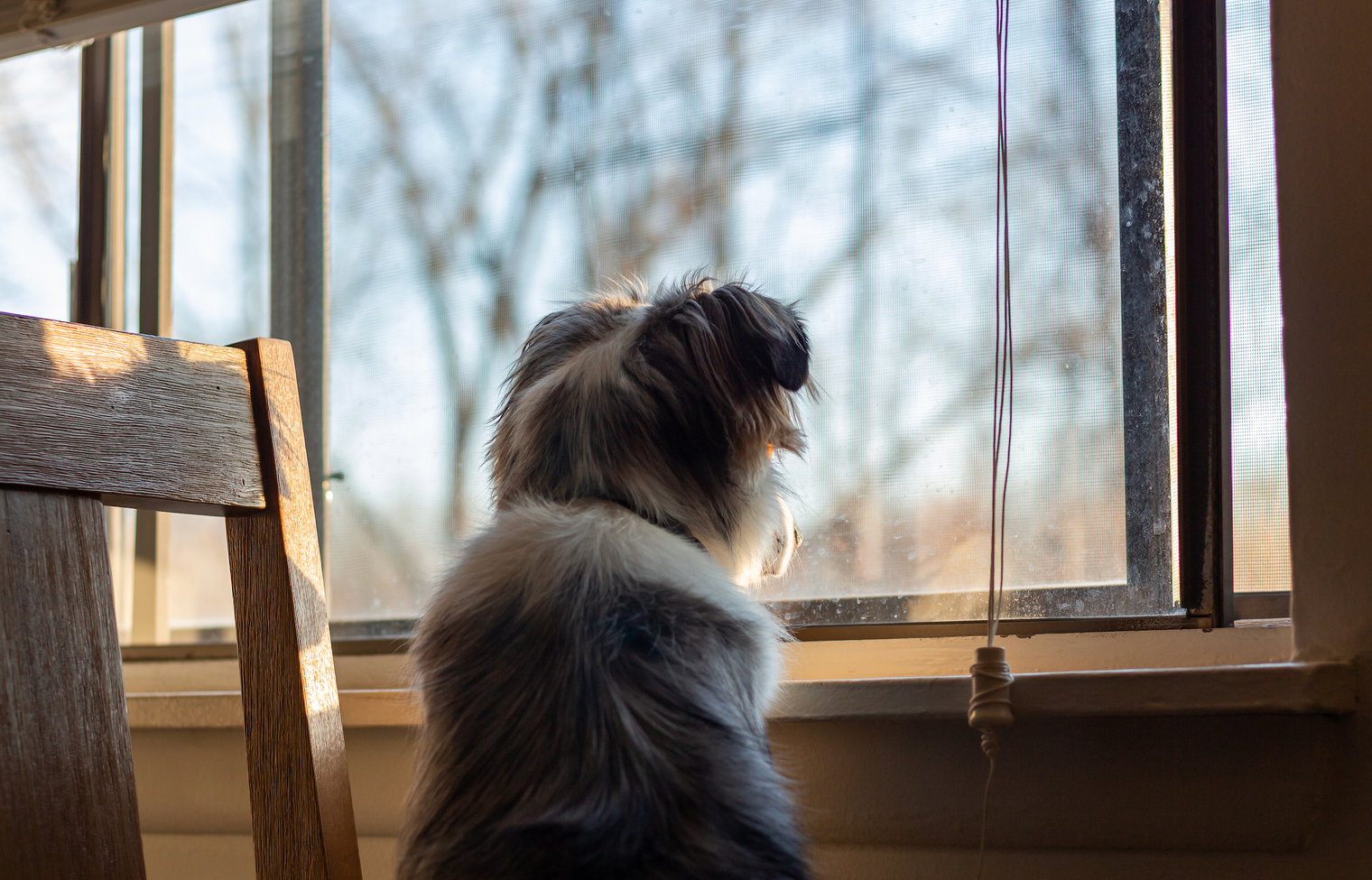If your dog destroys furniture, barks excessively, or shows distress when you leave home, you're likely dealing with canine separation anxiety - affecting up to 40% of UK dogs in 2025. According to a survey in 2022, roughly 8.8 million dogs might be affected by anxiety and depression in the UK.
This article provides practical solutions to help your pet stay calm when alone, identifies the key triggers causing this behavior, and shares expert-recommended training techniques validated by British veterinary behaviorists.

What Is Dog Separation Anxiety
Separation anxiety in dogs is a psychological condition where dogs experience significant distress when separated from their owners. This isn't just a dog being sad or bored—it's a serious condition that can impact both the dog's wellbeing and the owner's life. In the UK, between 14-20% of dogs suffer from some form of separation-related behavior.
When dogs with separation anxiety are left alone, they may bark continuously, destroy furniture, have bathroom accidents, or attempt to escape. These behaviors aren't signs of poor training but are distress responses—similar to panic attacks in humans.
Dog Separation Anxiety Causes
Genetic Predisposition
Some dogs are simply more prone to anxiety due to their genetic makeup. Certain breeds show higher rates of separation anxiety than others.
Lack of Socialization
Dogs that haven't been properly socialized during their critical development period (typically between 3-14 weeks of age) often struggle with being alone. Without early exposure to different situations, including brief periods of separation, puppies don't learn that being alone is safe and temporary.
A dog that's never learned to self-soothe or entertain itself struggles when suddenly faced with solitude. This is especially relevant for dogs adopted during the COVID-19 pandemic, when many puppies grew up with constant human companionship.
The lockdown effect created what some behaviorists call "pandemic puppies"—dogs who never experienced normal periods of being left alone during their formative months, creating a generation particularly vulnerable to separation issues.
Traumatic Events
Past trauma can significantly impact a dog's ability to handle separation. Dogs rescued from shelters or those with a history of abandonment often develop intense anxiety when their new owners leave, fearing they won't return.
Changes in Routine or Environment
Dogs thrive on routine and predictability. Major life changes—moving homes, a family member leaving, schedule changes, or even rearranging furniture—can trigger separation anxiety in previously well-adjusted dogs.
Identifying the root cause of your dog's separation anxiety allows for a more tailored approach to treatment, increasing the chances of successful management and creating a happier life for both you and your dog.
Dog Separation Anxiety Symptoms
Before you can help your dog, you need to know what separation anxiety looks like. A 2022 survey found that 47.38% of dog owners observed anxious behaviors in their pets due to separation, representing a 760% increase compared to previous years.
Common symptoms of separation anxiety include:
-
Excessive barking, howling, or whining when left alone
-
Destructive behavior (chewing furniture, scratching doors)
-
Pacing, restlessness, or walking in circles
-
Following you from room to room when you're home
-
Accidents in the house despite being house-trained
-
Excessive drooling or panting
-
Loss of appetite when you're away
-
Self-harm behaviors like excessive licking or chewing
Remember that separation anxiety develops over time, and it will take time to resolve. With patience, consistency, and the right approach, most dogs can learn to feel comfortable when left alone.
Recommended Supplements For Calming Dogs
Pawsitive Calm - Calming & Stress Support Powder
Key Benefits
-
Supports and maintains a sense of calm
-
Promotes relaxation during times of change or environmental disruption
-
Helps maintain composure and overall emotional balance
-
Formulated with 75mg of Lactium® per gram, with adaptable daily use based on pet weight
-
Contains carefully selected botanicals that support antioxidant activity and calm daily routines
-
Designed for gentle, long-term emotional support
-
Made with 100% natural and sustainable ingredients
How to Stop a Dog from Barking When Left Alone in the UK?
Dogs bark for many reasons when left alone - from boredom to anxiety to alerting about outside noises. About 8 out of 10 dogs feel stressed when left alone, and barking is one common way they show this stress. Excessive barking can create problems with neighbors and cause stress for both you and your pet. The good news is that with the right approach, you can help your dog stay quiet and calm when you're not home.
Use of positive reinforcement when quiet
Positive reinforcement works by rewarding your dog when they're not barking, teaching them that being quiet leads to good things. Start by identifying when your dog tends to bark most when alone. Then, set up practice sessions where you can reward quiet behavior.
Begin with very short absences - even just stepping out of the room for a few seconds. If your dog stays quiet, return and immediately reward them with a treat and calm praise. Don't make a big fuss when you return as this can increase excitement.
Gradually increase the time you're away, always rewarding quiet behavior. You can use a pet camera to monitor your dog and return before they start barking. This helps them learn that being quiet when alone results in rewards.
Employ commands like "quiet" paired with treats
Teaching a "quiet" command gives you a tool to communicate clearly with your dog. Here's how to do it effectively:
-
First, teach your dog a "speak" command by encouraging them to bark, then rewarding them.
-
Once they can bark on command, say "quiet" when they stop barking naturally.
-
Immediately reward them with a treat when they're silent.
-
Practice this sequence: "speak" (dog barks) → "quiet" (dog stops) → reward.
-
Gradually increase the time your dog must remain quiet before getting the reward.
Legal considerations in the UK
In the UK, persistent dog barking can be considered a statutory noise nuisance under the Environmental Protection Act 1990. Local councils can take action if neighbors complain about excessive barking, potentially leading to fines of up to £5,000.
While there's no specific "3 bark rule" in UK law (a common myth), councils generally consider factors like:
-
Duration of barking
-
Time of day or night
-
How often it occurs
-
How loud it is
The legal standard is typically whether the noise "unreasonably and substantially interferes with the use or enjoyment" of a home or other premises. This means occasional barking is acceptable, but constant barking while you're away could create legal issues.
To avoid problems, it's wise to:
-
Talk to your neighbors about your training efforts
-
Leave contact information so they can reach you if there are issues
-
Consider using a dog camera with bark alerts to monitor the situation
-
Address excessive barking promptly before it becomes a neighborhood issue
With patience, consistent training, and the right tools, most dogs can learn to stay calm and quiet when left alone. The key is addressing the underlying cause of the barking - whether that's anxiety, boredom, or territorial behavior - rather than just trying to silence the symptom.
How to Prevent Dog Separation Anxiety?
Long-term strategies for anxiety prevention
Creating lasting change requires systematic approaches that build your dog's confidence and independence. These strategies form the foundation of separation anxiety prevention.
Physical exercise is crucial before alone time. A tired dog is less likely to feel anxious. Aim for 30-60 minutes of activity based on your dog's age, breed, and health. This depletes excess energy that might otherwise fuel anxious behaviors.
Mental stimulation is equally important. Puzzle toys, training sessions, and scent work engage your dog's brain. Interactive toys like Kongs filled with frozen treats can occupy your dog for extended periods while you're away.
Staying calm during departures and returns
Dogs are remarkably perceptive to human emotions. When you project anxiety or guilt about leaving, your dog picks up these signals. Practice these techniques for calm departures:
-
Avoid emotional goodbyes that signal something concerning is happening
-
Maintain a neutral, matter-of-fact demeanor 10-15 minutes before leaving
-
Gather your belongings (keys, coat, etc.) without making a production
-
Exit without extended petting, baby talk, or apologies
-
Keep departures low-key and consistent every time
Upon returning home, resist the urge to create an excited reunion. While it might seem counterintuitive, enthusiastic greetings can actually increase separation anxiety by highlighting the contrast between your presence and absence.
Instead:
-
Enter calmly without immediately acknowledging your dog
-
Wait until your dog is settled before offering attention
-
Keep greetings brief and gentle
-
Resume normal activities to signal that departures and returns are routine
Legal Aspects: Leaving Dogs Alone
The UK has specific guidelines and legal frameworks regarding how long dogs can be left alone, which owners should understand to avoid potential legal issues. These regulations reflect growing recognition of dogs' social and emotional needs.
The RSPCA, the UK's leading animal welfare charity, strongly advises that dogs should not be left alone for more than four hours at a time. This guideline is based on research into canine stress responses when isolated. While this four-hour limit isn't explicitly written into UK law, it has become the standard benchmark used by welfare organizations and, increasingly, by courts when assessing potential neglect cases.
Conclusion
Living with a dog who suffers from separation anxiety can be tough on both you and your pet. The distress they feel when left alone shows in their behavior—excessive barking, destruction, or escape attempts—all signs of their deep attachment to you. But this condition isn't a life sentence. With consistent training, proper preparation, and perhaps some professional help, most dogs can learn to feel safe when home alone.
For UK dog owners, resources are plentiful. From behavioral specialists to support groups with other owners facing similar challenges, you're not alone in this journey. The RSPCA guidelines provide a framework for responsible care, and veterinarians across the country are equipped to help with both behavioral and medical approaches.

